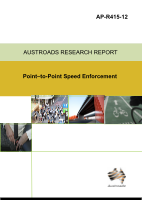Road Safety

- Publication no: AP-R415-12
- ISBN: 978-1-921991-42-4
- Published: 19 September 2012
- PDF (free) Download
This report reviews the use of point-to-point speed enforcement internationally in order to provide principles for better practice for its use in Australia and New Zealand. Point-to-point enforcement is a relatively new technological approach to speed enforcement which involves measuring the average speed of vehicles passing a series of cameras, by using automatic number plate recognition (ANPR) and other technologies. The approach has been implemented or trialled in a number of countries including Australia, New Zealand, the United Kingdom, the Netherlands, Austria, Italy, Switzerland and France. The major research activities were undertaken for the preparation of this report included: an extensive review of the international literature; and stakeholder consultation with international and domestic organisations.
To date, there have been no formal evaluations of point-to-point speed enforcement in Australia or New Zealand.
- ABBREVIATIONS
- GLOSSARY
- SUMMARY
- 1. INTRODUCTION
- 1.1. Structure of the report
- 1.2. Contributing role of speed to road trauma
- 2. PROJECT OBJECTIVES & METHODOLOGY
- 2.1. Literature review
- 2.2. Stakeholder consultations
- 2.2.1. Data collection
- 2.2.2. Interview schedule/questionnaire
- 2.2.3. Data analysis
- 2.3. Working group
- 3. EFFECTS OF POINT-TO-POINT SPEED ENFORCEMENT
- 3.1. Effects on vehicle speed
- 3.2. Crash fatality and injury reduction
- 3.3. Traffic flow improvement
- 3.4. Impact on traffic emissions and noise
- 3.5. Driver perceptions and self-reported behaviour
- 3.6. Costs and benefits of point-to-point enforcement
- 3.7. Comparison of effects between point-to-point and other types of enforcement
- 4. TECHNOLOGICAL OVERVIEW
- 4.1. Cameras/Illumination
- 4.1.1. Number of cameras and camera sites
- 4.1.2. Rearward-facing cameras, forward-facing cameras or both
- 4.1.3. Resolution, colour and type of camera equipment
- 4.1.4. Illumination
- 4.1.5. Camera activation system
- 4.2. Infrastructure
- 4.2.1. Camera housing
- 4.2.2. Mounting
- 4.2.3. Cabling
- 4.2.4. Time clocks
- 4.2.5. Power source
- 4.3. Processors and servers
- 4.4. ANPR/OCR engine and software
- 4.4.1. Accuracy
- 4.5. Communications network
- 4.6. Back office/Central processing unit
- 4.7. Legislative and policy issues
- 4.7.1. Potential legislative and ethical barriers to point-to-point implementation
- 5. FINDINGS FROM THE STAKEHOLDER CONSULTATIONS
- 5.1. Australia & New Zealand stakeholder consultations
- 5.1.1. Victoria
- 5.1.2. Queensland
- 5.1.3. New South Wales
- 5.1.4. South Australia
- 5.1.5. Australian Capital Territory
- 5.1.6. Western Australia
- 5.1.7. Tasmania
- 5.1.8. Northern Territory
- 5.1.9. New Zealand
- 5.2. Additional findings from the working group conducted with stakeholders from Australia and New Zealand
- 5.2.1. Enforcing average speeds across non-discrete speed zones
- 5.2.2. Enforcement tolerances
- 5.2.3. Legislative and evidentiary considerations
- 5.2.4. Mobile point-to-point speed enforcement
- 5.2.5. Shortest practicable distance
- 5.2.6. Environmental/noise reduction benefits
- 5.2.7. Clock synchronisation
- 5.2.8. Other technological aspects
- 5.2.9. Automation of the back office operations
- 5.2.10. Between-jurisdiction sharing of information
- 5.2.11. Number plate manufacturing and readability
- 5.2.12. Evaluating point-to-point speed enforcement systems
- 5.2.13. Consultations with Australian Motoring Groups and Additional Organisations
- 5.2.14. England
- 5.2.15. Scotland & Northern Ireland
- 5.2.16. The Netherlands
- 5.2.17. Austria
- 5.2.18. Italy
- 5.2.19. Switzerland
- 5.2.20. Belgium
- 5.2.21. Finland
- 5.2.22. France
- 5.2.23. Other countries
- 5.3. International stakeholder consultations
- 6. RECOMMENDATIONS FOR BETTER PRACTICE
- 6.1. Operational recommendations
- 6.2. Technological recommendations
- 6.3. Legislative and evidentiary recommendations
- 6.4. Public education recommendations
- 6.5. Evaluation recommendations
- 6.6. Privacy recommendations
- 6.7. Additional suggestions
- 6.8. Implications of findings for the Austroads Guide to Road Safety
- REFERENCES
- Appendix A. LIST OF SEARCH TERMS USED AND DATABASES SEARCHED
- Appendix B. INTERVIEW SCHEDULE
- Appendix C. ADDITIONAL STAKEHOLDER CONSULTATION FINDINGS
